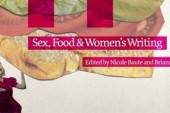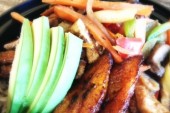
“My name is Brian. I’m a chef.” When I introduce myself to Parisians, there is a good chance they’ll burst out laughing, no matter whether I’m speaking French or English. It’s not my accent, my hair or what I wear. You have to be French to get it.
The French were self-admittedly as bad as western Canadians when it came to mastering a second language, in the past. But the youth are changing all of that. Almost everyone speaks English in school, and I’m hearing many compliments from tourists about how helpful the Parisians have become, humbling themselves with the cheap and crude English language.
“Where iz Brian?” “Brian iz in ze kitchen!” (Imagine an outburst of raucous laughter.) There you have it: these are about the first English words the French ever utter in their grade school English class. They all have the same textbook, so they all know it. Why is it so funny to repeat it as an adult? Nobody knows. Famous French comedian, Gad Elmaleh, also worked a whole sketch around asking where Brian was, and it is considered one of the legendary, side-splitting bits of stand-up comedy in France, which makes people laugh all the more when they hear it elsewhere.
At the vegetable and fruit market in Montmartre that I use a few times a week, one of the employees refuses to say Bonjour. Instead he always shouts out, “Where iz Brian?” even when there’s a crowd of other food shoppers separating us.
After many years of cooking in restaurants in Canada, Paris and the south of France, I’m now a freelance chef in and around Paris. I’m only in my client’s kitchens, chopping, slicing, stewing and serving, half the time, though. The rest of the time I’m pulling my shopping caddy through the shops and markets in search of whatever’s most likely to give people the most pleasure on their plate — obviously preferring the local and peak of the season. And whenever she can, Pauline Boldt is along for the ride, capturing those fleeting moments of food preparation and enjoyment. Cooking may not be an art, the cook’s efforts gobbled up in seconds after hours of preparation, but Pauline extracts little gems of art from the whole process with her resulting stunning images.
Getting out of the Chicken Rut
At some of the restaurants I worked at in Canada, the clients who came in and ordered the chicken dish off the menu were scoffed at: “F%$&ing Chicken Eaters!” I’m not a cursing kind of a chef, so trust me, this was not my colourful invention, but soon I realized it felt good to utter it when there were too many chicken orders coming in on any given evening. Chicken is a noun and an adjective, and ordering it symbolized the diner who was too unadventurous (and cheap) to try the more interesting and pricey stuff on the menu.
So next time you’re in the butcher, think of the disdain from some imaginary surly chef, and if they have something besides skinless chicken breast, go out of your comfort zone. For sure if the only chicken you can find spent its life in a cage, and is a boneless, skinless bit on blue cellophane under plastic wrap.
Here in Paris, we may be stuck under grim skies most of the year, elbow-to-elbow with Gitane-smoking, spitting and cursing Parisians, but almost any neighborhood butcher (the above mentioned corner in Montmartre has five butchers!) has at any given moment in his poultry case, three breeds of free-range chicken, guinea fowl, duck, squab, Cornish game hen, fresh turkey. That’s outside of the game season! Support your local butcher when he bothers to get in a bird that’s not chicken!
In these few shots, Pauline was able to tell half the story (perhaps we’ll share the first part of this story in another post). Dinner cooked up in some ancient apartment with creaking wood ceiling beams on rue Lapp in the Bastille neighborhood of Paris. What you can’t tell is that Pauline’s Eurostar train was late, the food market was then closed till late afternoon, my whole rolling knife and tool set had just gone missing (got it back a few days later!), there was no parking to be found, and the unknown kitchen turned out to be the size of 8-metre trawler galley-kitchen. I had gone for “Poularde rôti” that day, an oversized fattened hen, but the oven turned out to be the size of a large microwave and I almost had to force it in with my boot.
Following are some of the “recipes” from that memorable night of spontaneity. Thanks to the K. family for allowing us in with the camera.
Tarte Tatin au pain d’épices
5 baking apples 1 C. sugar 60 g (2 oz.) butter, cubed 2 T cider vinegar, optional 2 T ground cinnamon
Preheat oven to 190C/375F.
Peel the apples only if desired, cut in half, and core with melon baller. For the caramel, coat the bottom of a small, sturdy pot with about 3 T of the sugar, and put over medium high heat to dissolve without water.
When medium brown and dissolved, stir with wooden spoon, and add another 3 T. of the sugar.
Keep repeating the process till all the sugar has been added, is fully dissolved and medium brown in colour.
With the caramel still hot, but off heat, mix in the butter and the vinegar, and mix well. (Vinegar is optional to give added tartness unless your apples happen to be very tart already.)
Immediately pour into bottom of buttered tart pan, before caramel hardens.
Place flat side of apples down into caramel or for whole tart arrange, adding smaller pieces between, to fill the gaps, and create a flatter “top.” Generously sprinkle apples with cinnamon.
Bake about 30 minutes on bottom rack, or until apples are fully soft and caramelized, but not burning.
While waiting for the apples, prepare the crust:
Honey/spice crust
200g mild honey 70g butter 170g flour 1t baking powder 1t baking soda 35g fine-ground almonds 1 t of each: cinnamon, ginger, aniseed, nutmeg Pinch of salt, 2 medium eggs
Preheat oven to 175C/350F.
In a small pot, bring butter and honey to simmer and remove from heat.
Sift all dry ingredients in a bowl, make a well in centre and add hot honey.
Mix, then blend in beaten eggs, half at a time.
Butter a cake pan and place a circle of waxed paper on the bottom.
Cover evenly with batter and bake about 15 minutes, or until toothpick comes out clean.
Cool a minute but carefully remove from pan while warm to avoid breaking.
After apples have finished baking in caramel, remove pan and place baked crust over top. Invert either onto a plate and allow to sit overnight for apple juices and caramel to bond to crust; or, invert into a baking dish and bake in the oven another 10 minutes before serving. Serve with crème fraîche or full-fat sour cream sweetened with some honey.
Roasted sweet onions
Leave onions unpeeled, washing off any dirt if necessary.
Cut away only visible hairy bits of the root so the onion doesn’t fall apart in cooking.
Add to boiling salted water, simmer for 20 minutes.
Drain and peel while still warm.
Halve lengthwise.
Sprinkle with enough olive oil or melted duck fat to coat, sprinkle with fresh thyme and salt and roast in 400C oven about 20 minutes, flipping once if necessary to avoid burning.
Purple fingerlings in truffle butter
Scrub the potatoes and boil with skins on till tender in salty water.
Drain and peel before they cool.
Reheat whole or sliced with good quality black truffle butter (Tuber melanosporum) and a handful of chives, or regular butter with a little sprinkle of truffle vinegar.
Coarse sea salt to taste.
Beet, watercress and ginger soup
5 Large cooked beets, diced 1 T olive oil 2 large pink shallots, or 1 sweet onion, minced 2 T candied orange peel, or zest of 2 oranges/1 T honey 1 thumb-nub of fresh ginger, minced or grated 1 T sesame oil Salt, fresh ground pepper 2 litres stock (beef, chicken, or miso)
Garnish: 2 C. fresh watercress, washed and trimmed 1.5 T. olive oil 3-4 shiitake mushrooms, stem removed, thin sliced 1.5 T. sesame, hazelnut or walnut oil 1 T. apple cider vinegar, sea salt, sprinkle of sesame seeds.
Heat large soup pot, add oil and shallot.
Cover and sweat over low heat without browning, about five minutes.
Add beets, ginger, orange peel, stir, cover and sweat another 10 minutes.
Cover with stock, salt, and bring to simmer.
Purée with hand mixer, adjust seasoning to taste, and serve topped with watercress garnish (all ingredients tossed together.)
—
Brian DeFehr is a freelance chef in Paris. Brian can be hired for private cooking through www.briandefehr.com or found giving market cooking classes at www.cooknwithclass.com.
Pauline Boldt is a travel photographer, specializing in food, people and lifestyle. Follow her on Twitter @26MertonRoad More of Pauline‘s work can be found at www.26mertonroad.com.
For more, follow us on Twitter at @TorontoStandard and subscribe to our newsletter.














